Pest |
Attracted To |
Damage Caused |
Control |
|---|---|---|---|
28 Spotted Ladybugs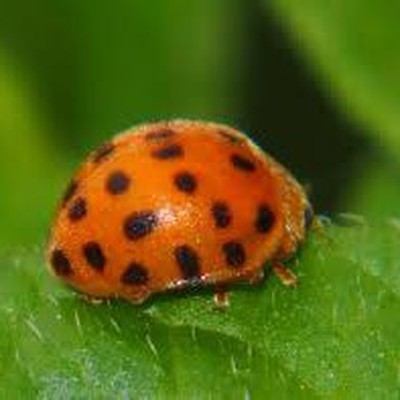
|
A wide range of crops, particularly from the Potato, Cabbage, Bean & Squash Families. |
Both adults and larvae feed on plant leaves, creating transparent holes. Their larvae are easy to recognise as they are a creamy/yellow colour, with a frizzy outline, they like to feed on the undersides of leaves. |
The problem with using harsh methods of control on 28 Spotted Ladybugs is that you may also harm beneficial lady bugs in the process. Manual removal of these bugs is best, handpick and dispose of them. Exclusion netting is a good option. Attract beneficial insects to feed on the beetles and their larvae. Remove any Blackberry Nightshade Weeds in and around your garden as they are hosts for this pest. |
Aphids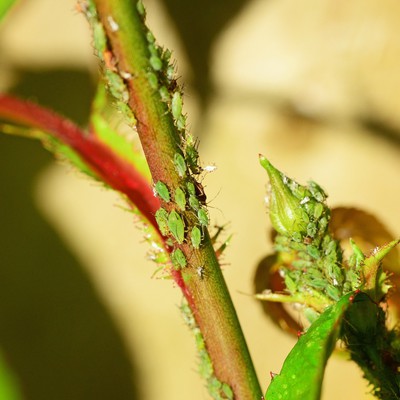
|
A wide very range of fruit and vegetable crops, particularly those in the Cabbage Family. |
Aphids feed on plant juices, attacking leaves, stems, buds, flowers and fruit. Look out for curling, stunted or yellowing leaves and distorted new growth. Check the undersides of leaves as Aphids love to hide there. A sticky substance on leaves is another sign that Aphids are present. If you see ants crawling on your plant, it's likely that Aphids are close by. Aphids produce a sticky substance known as 'honeydew' that the ants feed off. This sticky substance can cause Sooty Mold to form on leaves. Aphids also spread diseases such as Mosaic Virus. |
Wash Aphids off with a blast of water from the hose, water pressure is often enough to kill them. Add sticky traps around the base of your plants or place them throughout your garden to trap Aphids. Most beneficial insects like to feed on Aphids, so try attracting some to your garden. Insecticidal soap and botanical oil based insecticides work well to smoother these pests. Fruit-fly mesh and other forms of exclusion work well to protect crops. |
Armyworms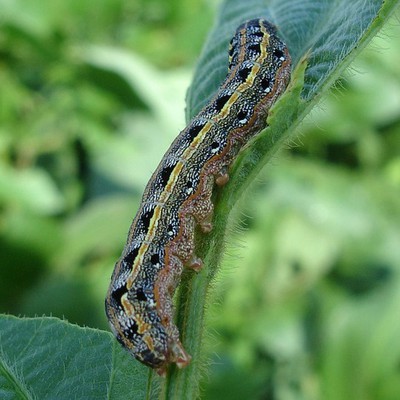
|
Cereal Crops- Wheat, Corn, Oats, Barley. Will also feed on many other crops including- Lettuce, Beans, Cabbage, Tomatoes. |
In spring, larvae feeds on grasses & low-growing plants. Later in the season the mature Armyworms move up to feed on plant leaves and fruit. Armyworms decimate leaves of Lettuce, Cabbage and Beans. They also burrow into Tomato fruits and ears of corn. |
Manual removal, handpick at night when they are most active. Look for larvae in early spring, they will most often be found feeding on the undersides of leaves and on new growth. Attract natural predators such as Birds, Minute Pirate Bugs, Ladybugs and Lacewings to your garden. Spray with Bacillus Thuringiensis (BT)- a naturally occurring bacteria found in soils which is deadly to these pests. It is safe to use in organic gardens and can be purchased from most nurseries. Fruit-fly mesh and other forms of exclusion work well to protect crops. |
Asparagus Beetles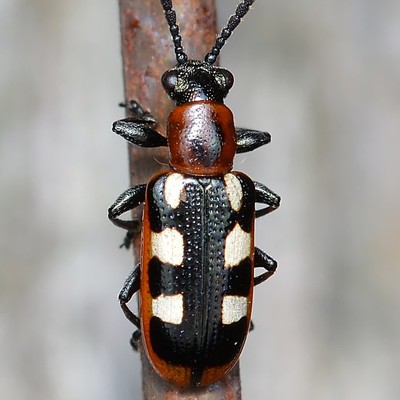
|
Asparagus plants |
Both adults and larvae feed on Asparagus plants and spears and can cause significant defoliation if not controlled. Asparagus Beetles lay their eggs along the spear in spring. Feeding can cause scaring and staining on plants, beetles also leave behind an excrement after feeding. Asparagus spears will appear twisted and hooked and the tips often turn brown as a result of the damage. Asparagus Beetle damage increases the plants susceptibility to Fusarium Wilt. |
Cutting back and disposing of dead ferns from the previous season will help remove any over-wintered bugs. Manual removal of insects, larvae and eggs in spring, as soon as spears emerge will prevent an infestation. Attract beneficial insects and predators to feed on the beetles- Lacewings, Ladybugs & Wasps, Birds & Lizards. Harvest crops early to prevent damage and starve off the insects. Botanical oil insecticide sprays also work to smoother insects at their larvae stage. |
Cabbage Loopers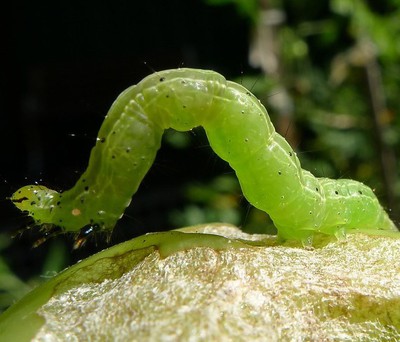
|
A wide range of crops, particularly those in the Cabbage Family. Will also attack other leafy greens as well as Cucumber and Tomato leaves. |
The Cabbage White Butterfly deposits small oval shaped, pale green eggs on plant leaves usually on the undersides. Eggs hatch in 3 or 4 days, that's when the caterpillars begin feeding on leaves, causing significant damage to plants. |
Manual removal- check the undersides of leaves regularly and brush off any eggs, pick off any caterpillars and dispose of them. Exclusion netting works well as it prevents the Butterflies from laying eggs on the leaves. Many beneficial insects such as Ground Beetles, Ladybugs, Lacewings, Parasitic Wasps feed on Cabbage Loopers. For larger infestations spray with Bacillus Thuringiensis (BT)- a naturally occurring bacteria found in soils which is deadly to caterpillars. It is safe to use in organic gardens and can be purchased from most nurseries. |
Cabbage Worms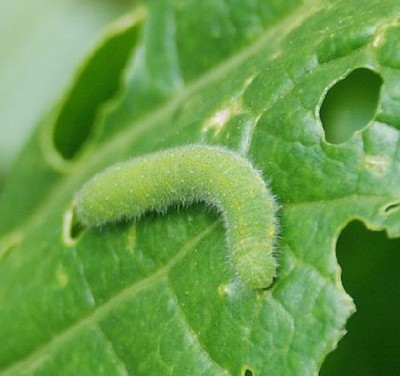
|
Crops from the Cabbage Family |
The Cabbage Moth lays hundreds of yellow eggs, usually on the undersides of leaves. These hatch into caterpillar larvae which feed heavily on the leaves. In the larval stage, Cabbage Worms will feed on the surface layer of leaves, causing a thinning of the leaf tissue and leaving behind translucent leaf scars. Older cabbage worms will chew large, irregular holes in leaves. Without control this pest can very quickly defoliate plants. Look out for dark green droppings which can often be seen on the leaves where caterpillars have been feeding. |
Manual removal- check the undersides of leaves regularly and brush off any eggs, pick off any caterpillars and dispose of them. Exclusion netting works well as it prevents the Butterflies from laying eggs on the leaves. Many beneficial insects such as Ground Beetles, Ladybugs, Lacewings, Parasitic Wasps feed on Cabbage Worms. For larger infestations spray with Bacillus Thuringiensis (BT)- a naturally occurring bacteria found in soils which is deadly to caterpillars. It is safe to use in organic gardens and can be purchased from most nurseries. |
Codling Moths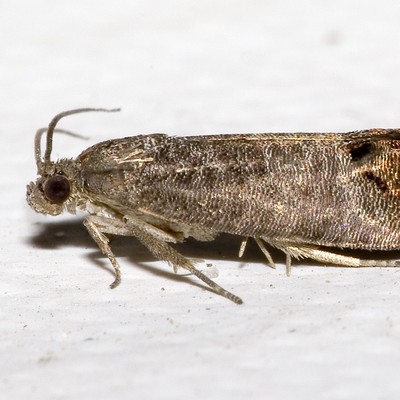
|
Apple, Pears & Quince |
Codling Moth larvae burrows into the fruit and feed on the insides. They often leave behind brown excrement which can be seen from the entrance hole on the outside of the fruit. |
Wrap hessian around the tree trunk, this attracts adult Codling Moths. After a few weeks, carefully remove the hessian and dispose of it, along with the moths that are hiding inside. Repeat the process. Quickly dispose of any affected fruit, particularly those that fall to the ground around the tree. This prevents the larvae inside from reaching maturity and starting the cycle again. Attract beneficial insects, particularly Predatory Wasps and Ground Beetles. Spray with botanical oil insecticides in winter to destroy over-wintering larvae. Mulch around your tree. Mulch provides a habitat for Spiders, Ground Beetles and Ants who feed on Codling Moth larvae. Exclusion netting can also be used to prevent the moths from laying eggs on your crops. |
Corn Earworms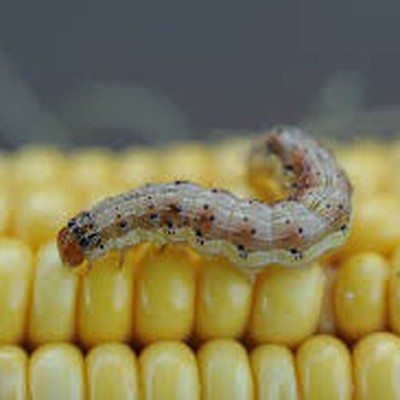
|
Corn, tomatoes and other fruiting vegetables, lettuce. |
Damage often begins in the corn’s silk, where the moth deposits its eggs. Once the eggs hatch, the caterpillars move down to the ear. Caterpillars cause extensive damage to the tips of the ear, where they consume the kernels and leave behind their fecal matter. The larvae often damages the silks before pollination can occur. |
Manual Removal- Turn over the soil before planting to expose pupae, remove them or allow chickens, ducks or other birds to consume them. Exclusion netting works well as it prevents the moths from laying eggs on the plant. Many beneficial insects such as Lacewings, Parasitic Wasps, Solider Beetles and Minute Pirate Bugs feed on them. For larger infestations spray with Bacillus Thuringiensis (BT)- a naturally occurring bacteria found in soils which is deadly to caterpillars. It is safe to use in organic gardens and can be purchased from most nurseries. |
Cucumber Beetles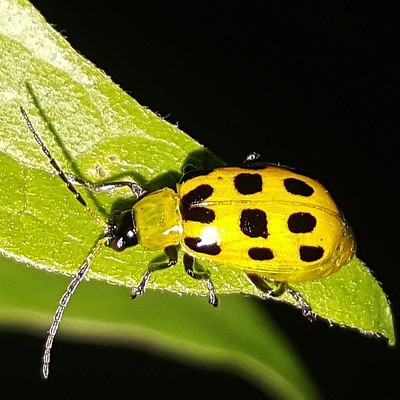
|
Cucumbers and all other crops from the Squash / Cucurbit Family. |
Beetles deposit hundreds of orange-yellow eggs in the soil near the base of plants. As eggs hatch, the larvae begins feeding on plant roots. Adult beetles feed on the leaves, flowers and fruit of all Squash Family crops, as well as Corn, Eggplant, Beans & Asparagus. Beetles also transmit diseases such as Bacterial Wilt and Mosaic Virus. |
Attract beneficial insects such as Soldier Beetles, Tachinid Flies, Ground Beetles, Wasps & Lacewings to feed both the beetles and their larvae. Manual removal of beetles as well as exclusion netting are also great methods of control and prevention. Botanical oil insecticides can be used in spring when Cucumber Beetles begin to emerge. Best applied in the early evening when the beetles are most active. Spray the plants weekly for 2-3 weeks. Treat plants again in early summer to eliminate any remaining larvae. Another treatment can be applied in late summer for precaution. |
Curl Grubs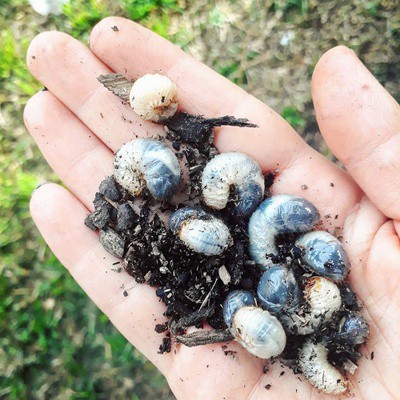
|
Most plants and lawns. |
Curl Grubs are the larval stage of various species of beetle including the African Black Beetle and Christmas Beetle. Beetles lay their eggs in the soil, where their larvae feed on the root systems of plants and lawns before emerging as beetles in spring. In large numbers, beetle larvae will cause significant damage to plants and may even result in plant death. Large browning patches of lawn and stunted plants are often a sign of Curl Grub infestations. |
Curl Grubs are generally found anywhere, from lawns, garden beds and compost heaps, to pots and hanging baskets. These grubs can be difficult to manage in large numbers. A few Curl Grubs in a large garden bed is expected and will not pose many issues at all. It is only heavier infestations that cause problems. Check potted plants for grubs regularly, particularly when re-potting. Remove any Curl Grubs from potted plants, as even a few will cause significant damage in an enclosed area. Before planting in the ground or in garden beds, turn over the soil to expose any Curl Grubs. Remove them by hand or allow birds, chickens and ducks to feed on them. Heavy watering or periods of rain will bring the grubs to the surface of the soil, allowing for easy removal. Minimise the use of outdoor night lighting as this may attract the beetles to your garden. Botanical oil insecticides can be sprayed in spring and summer, which is the peak time for grubs. |
Cutworms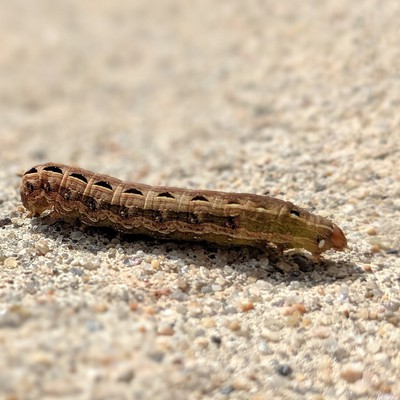
|
Most seedlings |
Hence the name, Cutworms literally cut young plants and seedling stems at or just below the soil surface, killing the plant. The majority of damage occurs at night when Cutworms are most active. |
Remove weeds and debris from in and around your garden as they provide a habitat for pests. Manual removal of Cutworms is an effective method of control. It is best done after dark, following heavy rain or after watering. Turn over the soil before planting to expose any Cutworms, remove them and feed them to birds or dispose of them. Exclusion is a great preventative measure. Create a boundary around your plants by using plastic pots or bottles with the bottoms cut out. Bury the sides of the pot or bottle an inch or so into the soil to prevent the grubs from crawling underneath. |
Diamondback Moths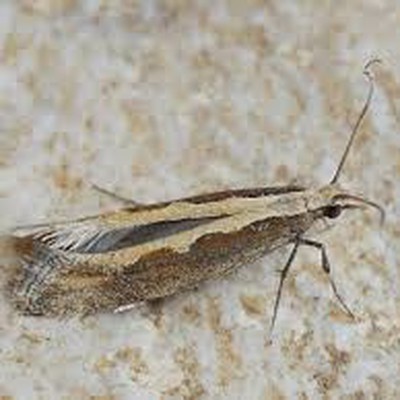
|
Crops from the Cabbage Family. |
Diamondback Moths lay small eggs on plants, generally on the undersides of leaves. Once they hatch, the larvae quickly decimate crops, leaving a number of small holes in the leaves between the leaf veins. The larvae also tunnel into the heads of plants such as Cabbage and Brussels Sprouts and pupate inside Broccoli florets and Cauliflower curds. |
Attract beneficial insects such as Ground Beetles, Ladybugs, Lacewings, Parasitic Wasps and Spiders, as they feed on the moths and their larvae. Manually remove pests. Check the undersides of leaves regularly, wipe off eggs and remove any caterpillars. Exclusion netting also works well to prevent moths from laying eggs on your crops. For larger infestations, spray with Bacillus Thuringiensis (BT)- A naturally occurring bacteria found in soils which is deadly to caterpillars. It is safe to use in organic gardens and can be purchased from most nurseries. |
Earwigs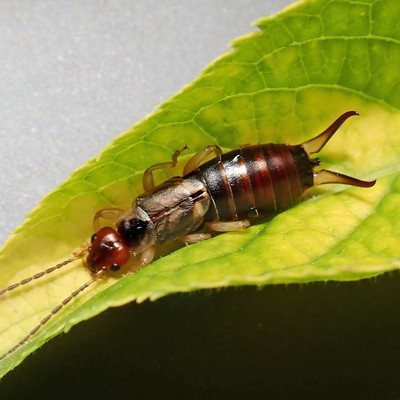
|
A range of crops including lettuce, celery, basil and fruit trees. While Earwigs do affect crops, they mainly feed on decaying plant matter and wood. Earwigs also eat a range of small pest such as Amyworms, Aphids, Grubs, Insect Eggs and Maggots. |
Damage appears as ragged edges and holes on leaves, mainly occurring after rainy weather which forces Earwigs to seek shelter on plants and leaves. If you notice plants on your potted plants, look underneath the pot as the earwigs are often hiding under there. |
Earwigs can be beneficial in small numbers. For larger infestations traps can be used to control them. 1.Roll up newspaper, dampen it with water and leave it around your garden beds. Earwigs will move in, after a few days dispose of the newspaper along with the earwigs. 2.Pour equal parts cooking oil and soy sauce into a plastic container. Puncture some holes into the lid, large enough for the earwigs to climb into. Bury the container in the garden bed until it's level with the soils surface. The earwigs will crawl in and won't be able to get back out. Dispose of the contents after a few days, repeat the process if needed. The same trap can be made using beer. Backyard chickens also help to control earwig populations. |
Flea Beetles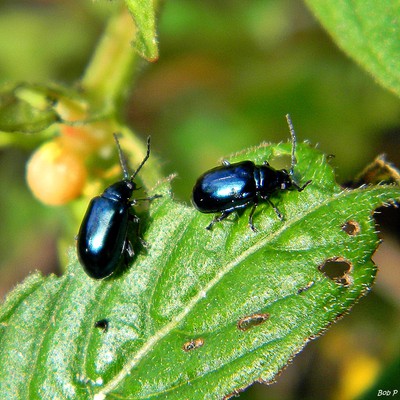
|
A wide variety of plants including Cabbage, Beans, Eggplant, Potatoes, Peppers,Tomatoes, Corn, Lettuce. |
Flea Beetles feed on plant leaves and stems, creating shallow pits and small irregular holes. When populations are high, these beetles can quickly defoliate entire plants. Flea Beetles also transmit viral and bacterial diseases to plants. |
Remove weeds from in and around your garden as these can host Flea Beetles. Row covers/fine netting can be used to protect seedlings and young plants until they are old enough to withstand the damage. Yellow sticky traps can be place throughout the garden to trap the beetles. Botanical oil insecticides can also be used for larger infestations. |
Fungas Gnats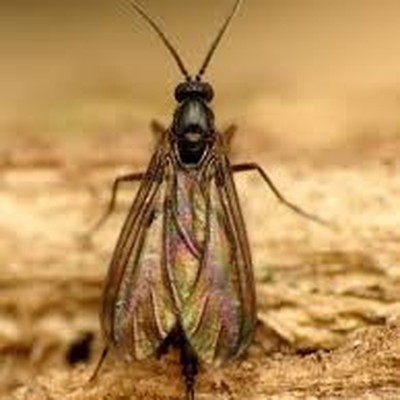
|
Most plants |
Fungus Gnats are harmless in small numbers. The Gnat itself causes no damage to plants, however the larvae feeds on plant roots. If numbers are large enough, this can cause significant damage to plants. Affected plants will appear stunted and develop yellowing leaves that will soon drop off. Fungus Gnats also spread a pathogen which causes Damping Off in seedlings. |
If Fungus Gnats appear, it is a sign that the soil is too moist. Let the soil dry out between watering. 1.Fill small dishes with apple cider vinegar and mix in a few drops of dish soap, place them in your garden beds just on top of the soil. Fungas Gnats are attracted to vinegar and will drown in there. Empty the contents and replace every few days. 2.For house plants, place a centimeter layer of sand on top of the soil, this will stop gnats from laying eggs in the soil and also prevent existing Gnat larvae from emerging from the soil. 3.Yellow sticky traps also work well against Fungas Gnats. See the 'Maintaining Your Garden' guide for more information on traps. |
Grasshoppers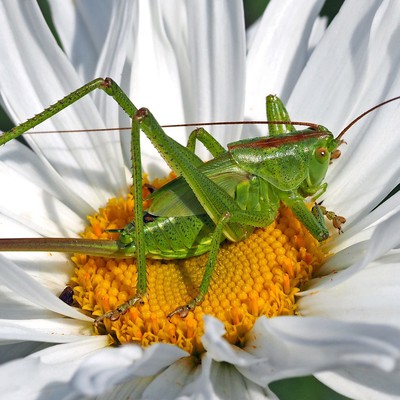
|
Most crops- including leafy greens, vegetables and fruits, some species feed on insects. |
Not all Grasshoppers are plant eaters. Some species are actually beneficial as they prey on a range of garden pests. Look for the spiny front legs which they use to catch their prey. Plant eating Grasshoppers cause damage by chewing on the leaves and stems of plants, both the adults and nymphs can be very destructive. |
Manual removal is a good way to eliminate grasshoppers. Pick the insects off plants and dispose of them, this is best done in the early morning. Exclusion netting is also a great way of protecting crops. Attract beneficial insects and predators such as, Preying Mantis, Spiders, Birds, Lizards & Frogs as they all feed on Grasshoppers. Garlic Spray also works well as a deterrent. |
Japanese Beetles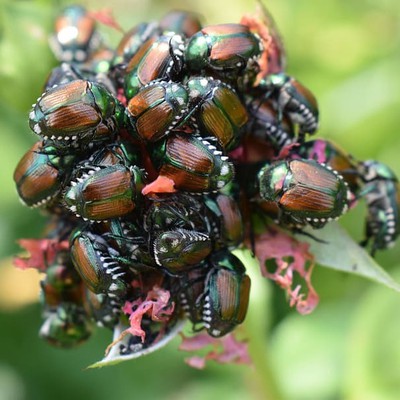
|
Most plants |
Japanese Beetles attack plants in large groups, causing significant damage. Japanese Beetles can leave plants looking skeletal by consuming the leaves and leaving only the veins remaining. |
Exclusion netting works well to protect crops, many traps can also be used. 1. Place a tarp or cloth around the base of your plants in the early morning. Shake the plant until the beetles fall off. Quickly fold up the cloth and dispose of the beetles. 2. Open some tinned fruit. Place the tin outside with the contents and juice still inside. After a few days, the fruit will begin to ferment, attracting the Beetles who will fall in and drown. 3. Plant Geraniums in or around your garden bed or simply place them in pots close by. Japanese Beetles are attracted to Geraniums. When they consume the plant they become paralysed and fall to the ground making them easy to collect. For large infestations, botanical oil and insecticidal soap sprays can be used to smother these insects. |
Leafhoppers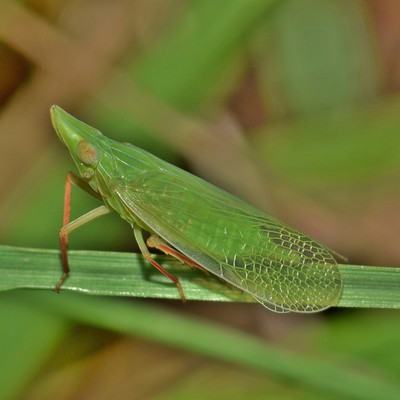
|
A wide range of crops including Potato, Beans, Corn, Lettuce, Grapes, Carrot, Parsnip, Celery, Roses. |
Both adults and nymphs feed on leaves by puncturing the undersides and sucking out plant juices. Leafhoppers cause pin prick like spots on leaves, similar to Spider Mite damage. Look for yellowing, curling leaves, stunted growth and distortion of plants. Leafhoppers also spread viruses to plants. |
Beneficial Insects & Predators such as Minute Pirate Bugs, Lacewings, Ladybugs, Damsel Bugs, Predatory Wasps & Flies, Lizards, Birds and Spiders feed on Leafhoppers and their Nymphs. Manual removal of insects as well as exclusion netting to protect crops are good methods of control and prevention. Insecticidal soap sprays can be effective on immature Leafhoppers (Nymphs). Garlic Spray works well as a deterrent. For more on sprays visit the 'Maintaining Your Garden' guide. |
Leafminers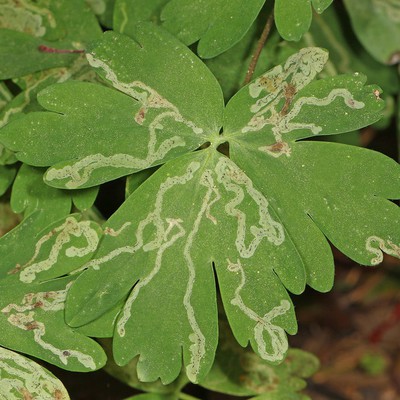
|
A wide range of crops including those from the Squash, Potato, Bean & Pea Families. Miners also affect many leafy green vegetables and are a common pest of Citrus trees. |
Leafminers are the larvae of little black flies. The larvae bore their way into the leaves of plants, causing unsightly squiggly lines to appear. Damage can also appear as blotches on leaves. Severe infestations can restrict plant growth and result in decreased crop yields. Most healthy plants can withstand a reasonable amount of Leafminer damage. |
At the first sign of tunneling, squeeze the leaf at the tunnel to crush any larvae. Dispose of affected leaves promptly. Beneficial Insects such as Predatory Wasps feed on these pests and are an effective form of control. Botanical oil insecticides & insecticidal soap sprays work well to suffocate larvae, however should only be used for large infestations as some of them can also harm beneficial insects. |
Mealybugs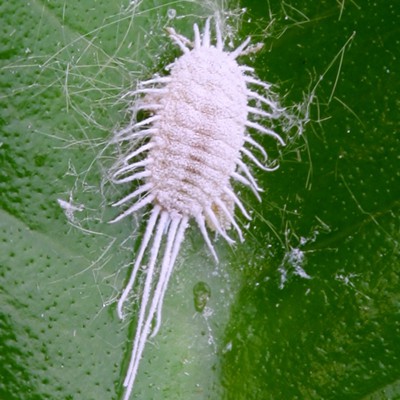
|
A wide range of trees and plants including Beans, Citrus, Peanuts, Cashew, Coffee, Cocoa, Guava, Sugarcane, Sweet Potato, Apple, Apricot, Grapes, Passion Fruit, Peach & Avocados. |
These soft bodied, wingless insects appear as white masses on the leaves, stems and fruit of plants. They feed by drawing sap out of plant tissue. If numbers are large enough this causes leaf yellowing, leaf curling and weakening of plants. Mealybugs leave behind a substance known as honeydew, which makes the plant sticky and encourages the growth of Sooty Mold. Mealybugs also have toxic saliva which infects plants, causing premature leaf drop and distorted growth. |
Attract beneficial insects such as Parasitic Wasps, Ladybugs, Predatory Beetles and Lacewings to feed on them. Manual removal of insects is an effective method of control. Mealybugs are very easy to wipe off your plants, you can use a stick to do this. A strong blast of water from the garden hose is also enough to kill Mealybugs. Reflective light is another great method of control. Place aluminum foil around the base of your plants, this will bounce light onto the underside of leaves which disorients the bugs. Insecticidal soap or garlic sprays are also are very effective against Mealybugs, don't forget to spray the undersides of leaves. |
Potato Beetles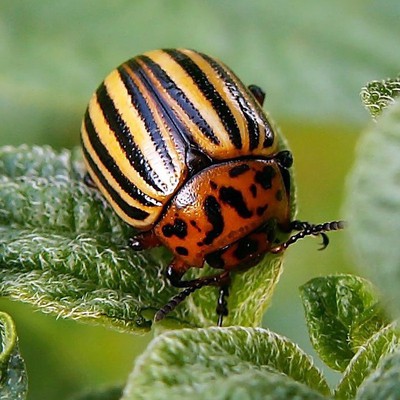
|
Crops from the Potato Family. |
Both beetles and larvae feed on plant leaves and can completely defoliate an entire crop in a short amount of time. Damage can reduce yields and in severe cases kill plants. |
For manual removal of beetles, place a tarp or large cloth underneath plants, preferably in the early morning and shake the plant until the beetles fall off. Dispose of the beetles. Beneficial insects such as Ground Beetles, Ladybugs and Lacewings feed on Potato Beetles and their larvae. Crop Rotation is an effective way to starve off any overwintering larvae or beetles. Exclusion netting is a great preventative method against these pests. Mulch the soil well to create a habitat for the beneficial insects who prey on Potato Beetles. Insecticidal soap & botanical oil sprays are effective against Potato Beetle Larvae. For more on all of these control methods, visit the 'Maintaining Your Garden' guide. |
Psyllids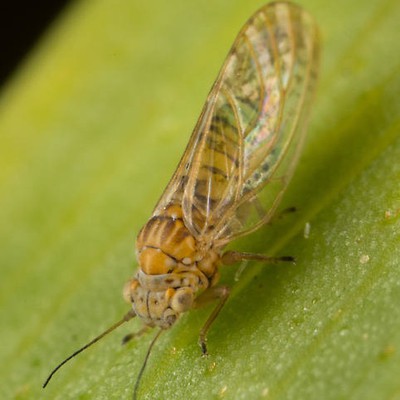
|
Tomato Potato Psyllid- Potato Family crops Citrus Psyllid- Citrus Trees Olive Psyllid- Olive Trees |
Psyllids are also known as plant lice, they cause damage to plants by sucking the sap out of plant tissue. Psyllids are at their peak in spring when temperatures are warm and plants are producing new growth. As they feed, Psyllids excrete a sticky substance called honeydew. Honeydew attracts ants and causes Sooty Mold to develop on plants. Damaged plants may appear distorted, discolored or may even die if the infestation is large enough. Some species can also cause defoliation. Psyllids mainly target new growth which can affect flowering and fruit production. |
Sticky traps placed throughout your garden are a good form of control. Beneficial insects such as Ladybugs and Lacewings feed on Psyllids, so try attracting some to your garden. Insecticidal soap and botanical oil insecticides, work well to smoother these pests. Fruit-fly mesh and other forms of exclusion are great preventative measures. |
Root Maggot Flies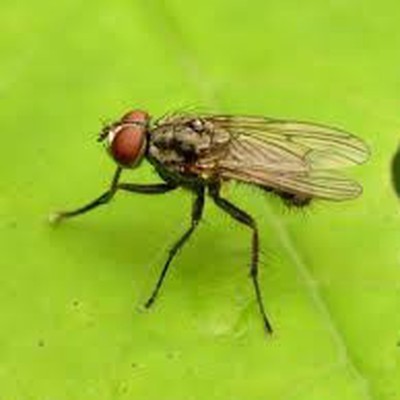
|
A wide range of vegetable crops from the Cabbage Family, Onions and Carrots. |
Root Maggot Flies look like regular house flies, only smaller. Maggots (Fly Larvae) are what cause the damage to crops as they feed on plant roots. Roots are often riddled with tunnels from the maggots eating their way through, this then causes root rot and diseases such as Black Rot. Affected plants will appear stunted, yellow and may wilt on warm days. Significant damage, particularly to tap roots will result in plant death. |
Root maggots can be tricky to control as by the time symptoms appear on the plant, the damage has already been done underground. Exclusion netting works well to protect crops from the flies. Beneficial insects such as Ground Beetles feed on the maggots. Root Maggot Flies prefer to lay their eggs in soils that are rich in manure, so if you find Root Maggots to be a consistent issue in your garden, limit the amount of manures you add to your soil. Crop rotation also helps to break the cycle. |
Scale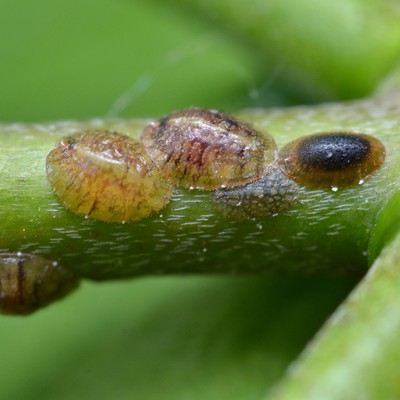
|
Many plants, particularly Citrus and Fig trees. |
Scale insects cause damage by sucking sap from plants, which robs them of essential nutrients. The insects usually cluster on the underside of leaves and around leaf joints, they can also be found along the stems of plants. Scale insects fall into 2 categories- Armored Scale and Soft Scale and both can be quite destructive. Armored scale are the most difficult to control, particularly once they are mature. Soft Scale insects excrete honeydew, which causes Sooty Mold (a black substance) to form on leaves. Sooty Mold interferes with the plants ability to perform photosynthesis. Damaged plants may appear withered and yellow spots will appear on leaves. Leaves will eventually turn yellow and may drop from the plant. Plants that are severely affected will produce very little to no new growth. If new growth does develop, it may appear distorted. |
Manually remove scale by gently scraping them off the plant as they first appear. This works well, although can be very time consuming in large infestations. Insecticidal soap and botanical oil based insecticides can be used to smother the scale insects, preferably used before the Armored Scale are mature. Once mature it can be hard for the insecticide to penetrate the shells. Attracting beneficial insects is also a good form of control. |
Slugs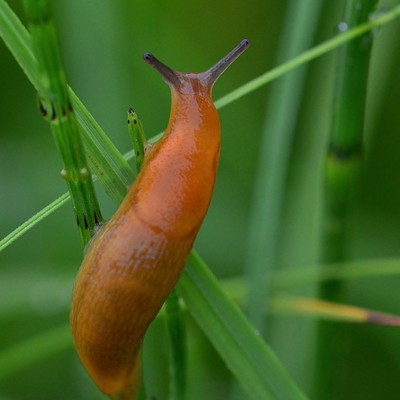
|
Most plants, particularly seedlings and low lying crops such as strawberries and leafy vegetables. |
Slugs are attracted to shady, damp spots and often hide under foundations, rocks or mulch. They are most active at night, feeding heavily on a variety of crops. Slugs create large holes in foliage and can completely destroy seedlings and tender plants. Slugs secrete a slimy substance when they glide, which appears as silvery trail. |
Handpick Slugs off your plants and dispose of them. This control method is best done at night when they are most active. Trap Slugs by placing a shallow container of beer on the soils surface, Slugs are attracted to it and will fall in and drown. Crushed eggshells and coffee grounds are a great deterrent as Slugs do not like crawling over them. Beneficial insects and predators including Ground Beetles, Praying Mantis, Centipedes, Chickens & Ducks, Lizards and Frogs will feed on Slugs. |
Snails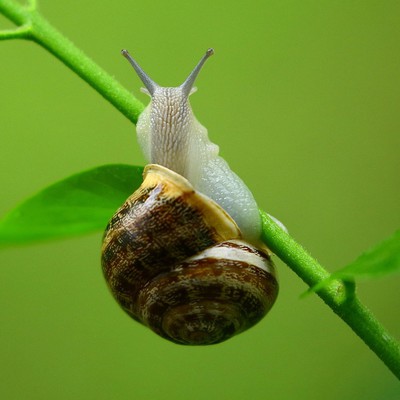
|
Most plants, particularly seedlings and low lying crops such as strawberries and leafy vegetables. |
Snails are attracted to shady, damp spots and often hide under foundations, rocks or mulch. They are most active at night, feeding heavily on a variety of crops. Snails create large holes in foliage and can completely destroy seedlings and tender plants. Snails secrete a slimy substance when they glide, which appears as a silvery trail. |
Handpick Snails off your plants and dispose of them. This control method is best done at night when they are most active. Trap Snails by placing a shallow container of beer on the soils surface, Snails are attracted to it and will fall in and drown. Crushed eggshells and coffee grounds are a great deterrent as Snails do not like crawling over them. Beneficial insects and predators including Ground Beetles, Praying Mantis, Centipedes, Chickens & Ducks, Lizards and Frogs will feed on Snails. |
Spider Mites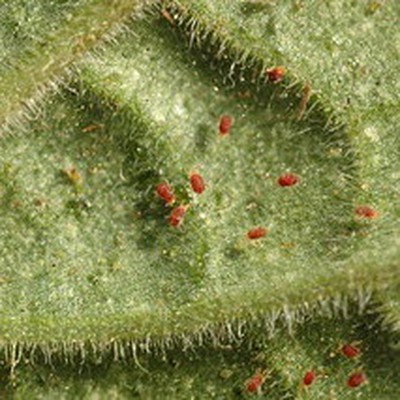
|
Most crops |
Spider Mites live in large colonies and are commonly found on the underside of leaves, appearing as little red/brown specs. Mites feed by piercing into plant tissue and sucking the sap (plant fluids) from leaves. The damage presents itself as light coloured dots, almost like pin pricks on the surface of leaves. If not controlled, the leaves will turn yellow and will eventually dry up and fall off. Severe infestations are accompanied by fine silvery webbing on the undersides of leaves and on stems. |
Prune off heavily affected leaves and dispose of them, do not compost them. If a plant is heavily infested with mites and webbing, it is best to remove the whole plant and dispose of it to prevent the mites from spreading to neighbouring plants. In smaller numbers, you can wash mites off with a blast of water from the hose, concentrating on the undersides of leaves. This is an effective method of control as the water pressure is generally enough to kill them. Attract beneficial insects such as Ladybugs, Lacewings and Predatory Mites as they are great natural predators. Insecticidal soap and botanical oil sprays are an effective method of control. Treatment should be repeated weekly or fortnightly until the problem resolves. |
Squash Bugs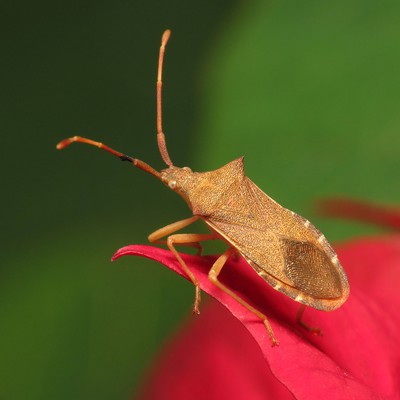
|
Plants from the Squash / Cucurbit Family |
Squash Bugs are often mistaken for Stink Bugs as they both have a foul odor when squashed and are quite similar in appearance. Stink Bugs however, are wider and rounder than Squash Bugs. Squash Bugs overwinter on old vines, under dead leaves, garden materials and buildings. They come out of hiding in spring when vines start forming, laying masses of eggs on the undersides of leaves. You will spot adult bugs near the plants crown and under damaged leaves. These bugs feed on both the vines and fruit of Squash Family plants, the damage caused is extremely destructive. Squash Bugs pierce plants and suck out the sap, causing yellow spots on leaves that soon turn brown. Leaves will begin to wilt and collapse as a result of the sap being drained from them. Additionally, the saliva released from these bugs during feeding carries bacteria that is toxic to Squash Family crops. |
Early detection is crucial! Removing beetles at egg stage eliminates them before any damage has been caused to the plant. Simply wipe egg masses off plants, also remove any beetles as you find them. Check plants daily and continue to collect and destroy bugs and eggs as you find them. Trap bugs by placing a wooden board, hessian bag or something similar under your plants. During the night the Squash Bugs will shelter underneath, collect the bugs in the early morning and dispose of them. Attract beneficial insects such as Tachinid Flies & Praying Mantises. Prevention is key when it comes to Squash Bugs. Do not compost old vines that have been affected as the bugs may over-winter in your compost pile. Practice crop rotation, plant Squash Family crops in a different location in your garden the next season, by doing this you will starve off any over-wintering Squash Bugs. You can use fine netting, such as fruit fly mesh to cover your plants. Only remove covers once blossoms appear, so that pollination can occur. By covering your crops for the first month of spring you have great change of avoiding Squash Bugs all together. |
Squash Vine Borers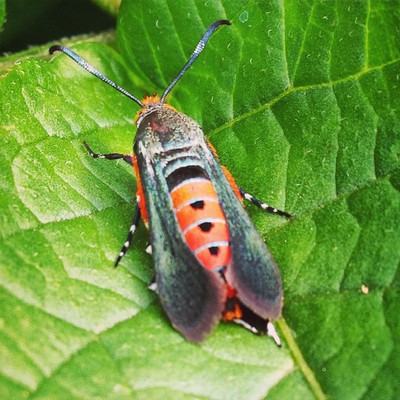
|
Plants from the Squash / Cucurbit Family |
If healthy squash plants suddenly start to wilt, the culprit is usually a Squash Vine Borer. Moths which look similar to wasps lay their eggs around the base of the plants. When the eggs hatch, the larvae cut into the stem and begin to bore into them, feeding on the insides as they go. This damage causes the stems to rot. Sawdust like droppings at the base of squash plants are a good indication that Squash Bugs are inside. |
If you notice damage to your plant stems in the form of holes and sawdust like excrement at the base of your plants, carefully insert a wire through one of the holes. Keep threading through, particularly if you feel some hollow spaces in stem. This method will hopefully kill any larvae that are inside. Gently remove the wire afterwards. Manual control of the moth is also beneficial, look out for them in the early morning or evening and attempt to catch and destroy them. You may find them sitting on the leaves of the squash plants. Insecticidal soap sprays and botanical oil insecticides can be applied early to kill freshly hatched larvae before they make their way into the stems. Note: Prevention is key when it comes to Squash Vine Borers. Do not compost squash vines that have been affected as borers may over-winter in your compost pile. Practice crop rotation, by changing your planting location the next season, you will starve off any over-wintering Squash Bugs. Wrapping the stems of your squash plants can help prevent larvae from burrowing into them. Bandages, old stockings or even aluminium foil can be used. Make sure the wrap extends 1cm below the soils surface as an added measure. Attracting beneficial insects such as Parasitic Wasps to your garden prior to planting is also a great organic control. Fine netting or fruit fly mesh can be used to cover your plants. Remove covers once blossoms appear, so that pollination can occur. |
Stink Bugs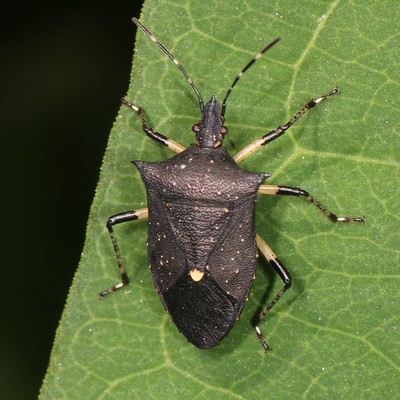
|
A variety of crops, particularly Citrus, Corn, Okra, Amaranth and fruit trees. |
There are numerous species of Stink Bug which go by many names. Stink Bugs pierce the outer surface of leaves and fruit, injecting saliva and sucking out plant juices. This causes dimpling of the fruit's surface, it also causes rotting inside the fruit. Stink bugs may taint fruits with a bad taste and smell, making them inedible. |
Encourage beneficial insects and predators to your garden, including Minute Pirate Bugs, Praying Mantis, Lacewings, Ladybugs, Parasitic Flies, Spiders and Birds. Manual removal of bugs as well as exclusion netting are great methods for control and prevention. Botanical oil insecticides can be applied, although best used when Stink Bugs are immature (Nymphs). You may need to repeat the treatment a few times. |
Thrips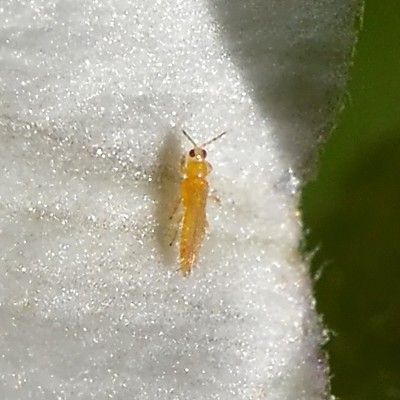
|
Most crops |
Thrips are sap sucking insects that affect a very wide variety of crops. Thrips cause significant damage to plant leaves, flowers and fruit. They are often found hiding in new shoots or flower buds. Look out for deformities in new growth, stunted seedlings, damaged and browning flower buds, premature flower and fruit drop and a silvery, speckled appearance on leaves. |
There are a large number of beneficial insects which feed on Thrips, try attracting some to your garden (See the 'Beneficial Insects' guide for me information). In small numbers, Thrips can be hosed off with a spray of water, focusing on the underside of leaves and on new growth. Insecticidal soap sprays and botanical oil sprays also work well, don't forget to spray the undersides of leaves. Use yellow sticky traps around your garden to capture adults. Remove weeds and debris from the garden as they may host Thrips. Use aluminium foil at the base of your plants as a deterrent, Thrips don't like the reflective light. Remove severely damaged plants or trim off badly affected parts. Remove any affected flower buds or fruit, do not place them in your compost. |
Tomato Hornworms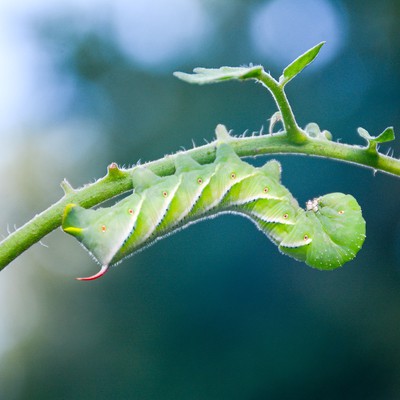
|
Tomato plants, will also feed on Eggplant, Peppers and Potato plants. |
Hornworms usually start feeding from the top of plants and work their way down. Keep an eye out for chewed or missing leaves. Check the tops of plants for dark green/black droppings, this is a sign that Hornworms have been feeding close by. Check the undersides of leaves close to where the droppings are and you will most likely find the culprit. Tomato Hornworms blend in very well with tomato leaves and often go unnoticed until severe damage has been done. Hornworms are known to defoliate whole plants in a short amount of time. Look for stems that are missing their leaves or foliage that is hanging down, you may find cacoons or Hornworms hanging off them. |
Once you spot Hornworms on your plants, you need to act fast. Handpicking Hornworms off your plants is one of the best methods of control, particularly in a small scale garden. Beneficial insects such as Parasitic Wasps are also a great form of control against Hornworm. If the problem persists, spray with Bacillus Thuringiensis (BT)- a naturally occurring bacteria found in soils which is deadly to caterpillars. It is safe to use in organic gardens and can be purchased from most nurseries. |
Two Spotted Mites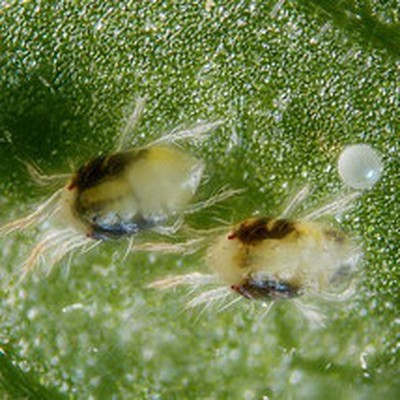
|
A wide range of crops |
Two Spotted Mites live in large colonies and are commonly found on the underside of leaves, they can be quite hard to see. Mites feed by piercing into plant tissue and sucking the sap (plant fluids) from leaves. The damage presents itself as light coloured dots, almost like pin pricks on the surface of leaves, causing a mottled appearance. If not controlled, the leaves will turn yellow and will eventually dry up and fall off. Severe infestations are accompanied by fine silvery webbing on the undersides of leaves and on stems. |
Prune off heavily affected leaves and dispose of them, do not compost them. If a plant is heavily infested with mites and webbing, it is best to remove the whole plant and dispose of it to prevent the mites from spreading to neighbouring plants. In smaller numbers, you can wash mites off with a blast of water from the hose, concentrating on the undersides of leaves. This is an effective method of control as the water pressure is generally enough to kill them. Benefical insects such as Ladybugs, Lacewings and Predatory Mites are great natural predators. Insecticidal soap and botanical oil sprays are an effective method of control. Treatment should be repeated weekly or fortnightly until the problem resolves. |
Weevils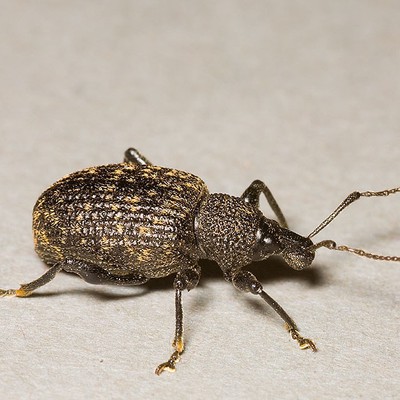
|
Most crops, particularly Berries, Apple, Pear, Plum, Peach and Nectarine trees. |
Adult weevils chew on the edges of leaves, creating scalloped bite marks, they also attack flower buds and fruit. Weevil larvae are soil-dwelling and feed on plant roots causing them to become stunted. |
If you Weevils become a problem in your garden, remove mulch and other debris from around your plants as these provide shelter for the Weevils. Only water your plants when necessary as Weevils and their larvae prefer moist soil. Place burlap around the base of the plant/tree, the weevils will crawl in there to hide. After a couple of days, preferably in the early morning, remove the Burlap and dispose of any bugs you can find. Beneficial insects such Ladybugs and Lacewing feed on Weevil larvae, try attacking them to your garden. Botanical oil insecticides can be applied in spring to kill any over-wintering Weevils and eggs before they emerge. |
Whiteflies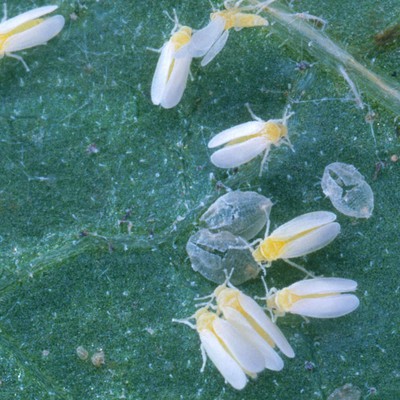
|
Warm weather crops such as Tomatoes, Cucumber, Peppers, Eggplant, Okra and Sweet potato. They are also attracted to plants from the Cabbage Family. |
If you notice little white specs flying away as soon as you touch your plants, then you have Whitefly. Whiteflies are soft-bodied, winged insects that often cluster on the underside of leaves. Whiteflies suck the juices out of leaves causing them to become weak. Leaves will wilt, turn pale or yellow and plant growth will become stunted. While feeding, Whiteflies produce honeydew, a sticky substance which causes Sooty Mold to form on leaves. Honeydew also attracts ants. |
Spray plants with insecticidal soap, don't forget to coat the undersides of leaves. This spray works to kill and deter Whitefly. Hang yellow cardboard that has been coated in double sided tape or glue around your garden, the colour will attract the Whitefly and the glue will trap them. Attract beneficial insects such as Ladybirds, Lacewings, Hoverflies and Dragonflies. These insects feed on Whitefly as well as their eggs and larvae. For heavy infestations, use a handheld vacuum to suck up Whitefly, including their eggs and larvae. Reflective mulch, such as aluminium foil can be used to confuse Whitefly, making it hard for them to find your crop. |